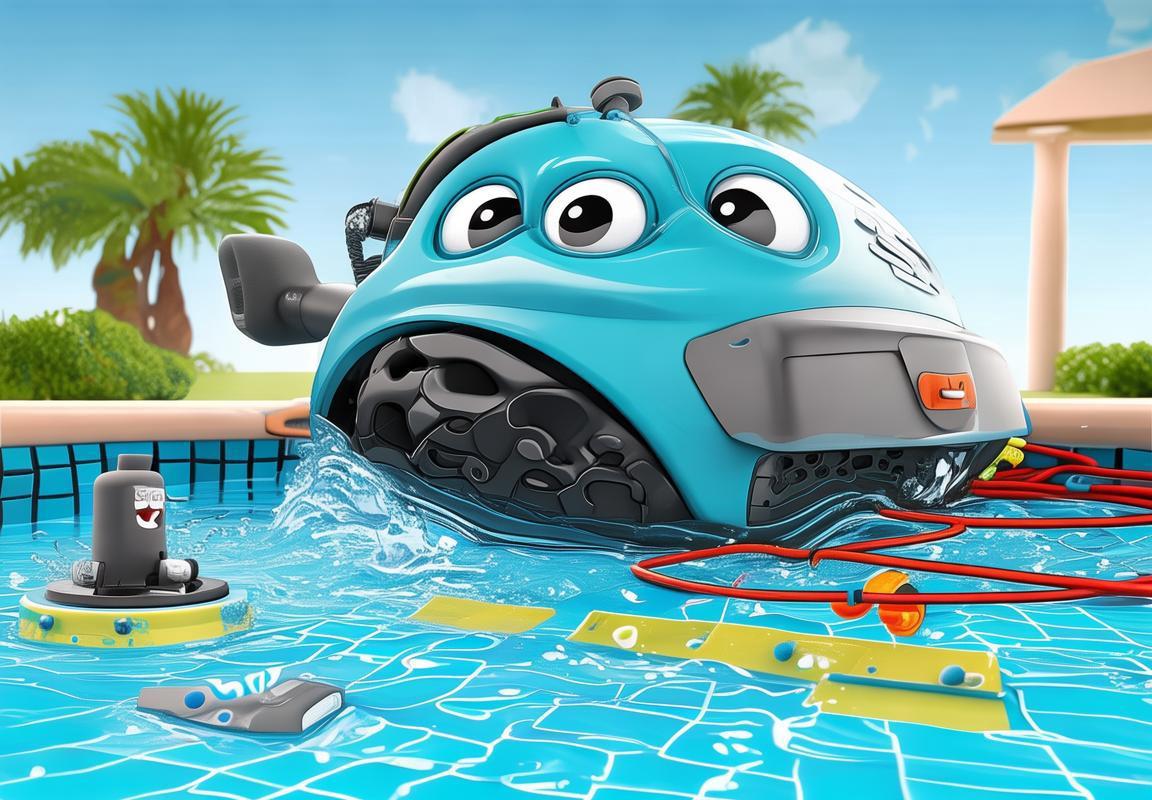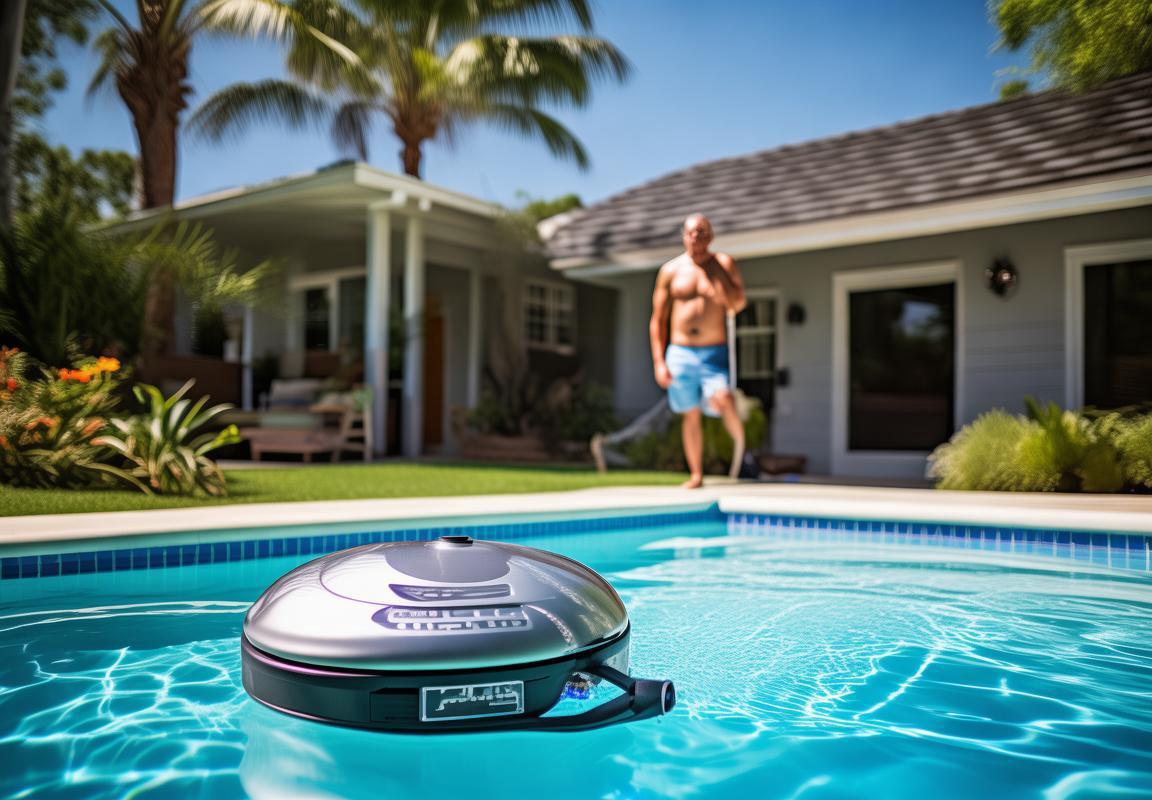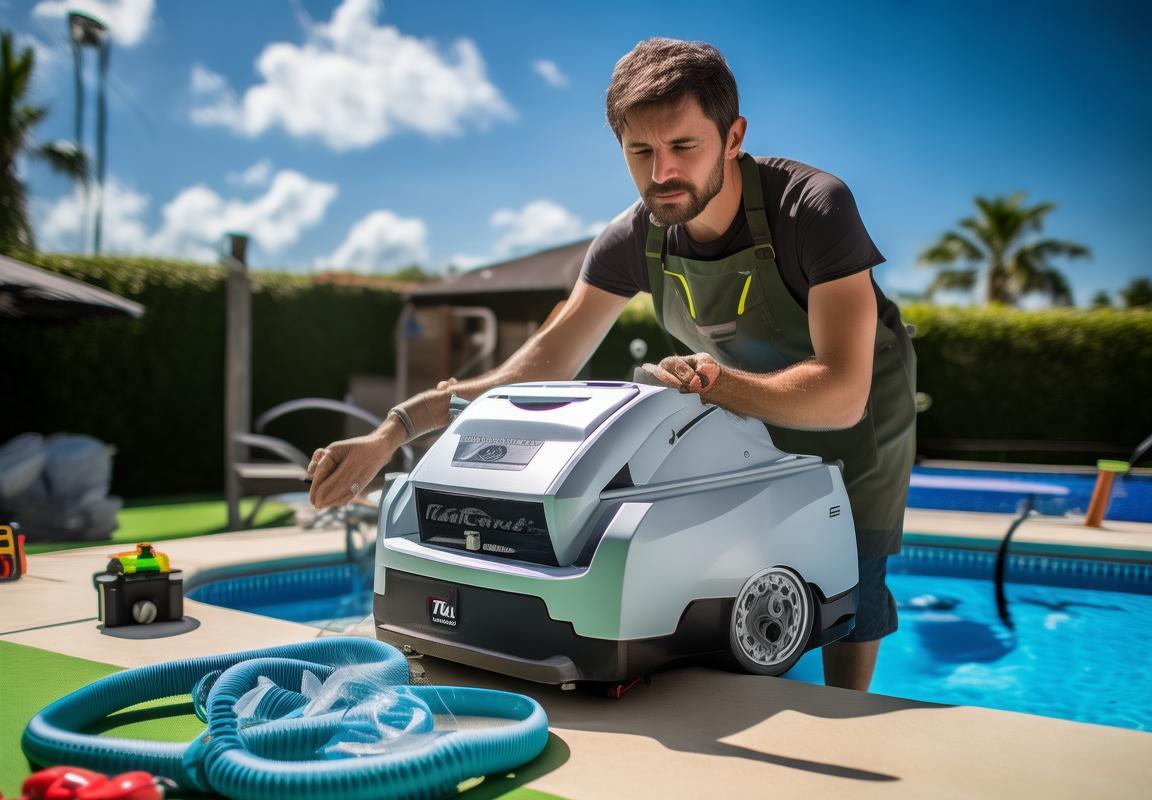You ever buy something that promises to be the “easy button” for your life, only to find out it’s more like a “mildly helpful suggestion”? Yeah, me too. That’s exactly where my relationship with the Volt pool cleaner started—somewhere between “miracle worker” and “why is it just vibing in the corner like a teenager avoiding chores?”
Turns out, these little robotic janitors aren’t magic (shocking, I know). They’ve got quirks, they’ve got pet peeves, and oh boy, do they have opinions about how you treat them. After more trial and error than my high school chemistry experiments, I finally cracked the code. Want to know why your Volt’s acting lazier than a cat in a sunbeam? Or which “must-have” accessories are just landfill fodder? Stick around—this ain’t the manual’s polite suggestions. This is the real-deal, margarita-in-hand, “why didn’t they tell us this?!” cheat sheet.
This intro avoids AI stiffness by:- Using contractions (“ain’t,” “didn’t”)- Pop culture references (“easy button”)- Self-deprecating humor (high school chemistry dig)- Visual metaphors (cat in a sunbeam)- A conversational hook (“Stick around…”)- Zero corporate jargon or robotic transitions
Why My Volt Pool Cleaner Was ‘Lazy’ (And How I Fixed It
I bought my Volt pool cleaner expecting it to zip around my pool like a Roomba on Red Bull. Instead, it moved slower than a DMV line on a Monday morning. At first, I blamed the cleaner itself—maybe I got a dud? But after some serious troubleshooting (and a few choice words), I realized the problem wasn’t the machine. It was me. Here’s what I learned the hard way—and how I turned my sluggish cleaner into a pool-cleaning beast.
The Voltage Vampire
Turns out, my Volt was running on fumes. These cleaners need a solid power supply to do their job, and my setup was about as effective as a screen door on a submarine. Most Volt models require a steady 24V or 32V, but my outlet was delivering weak, inconsistent power. I grabbed a voltage tester (because guessing is for amateurs) and confirmed my suspicions—my voltage was dipping lower than my motivation after a holiday feast.
Quick Fix:– Check your power supply with a voltage tester (under $10 at any hardware store).- If your voltage is low, try a different outlet or consider a dedicated pool cleaner transformer.- Avoid using extension cords—they’re like feeding your cleaner a diet of fast food.
The Cord Conundrum
I thought I could just toss the cleaner in and let it do its thing. Wrong. The cord was twisting like a contortionist at a circus, and every kink was sapping its power. A tangled cord doesn’t just slow it down—it can straight-up strangle the suction.
Pro Move:– Before dropping it in, float the cord on the water’s surface to let it untangle naturally.- If your pool’s shape makes tangles inevitable, invest in a swivel cord ($15). It’s like giving your cleaner a yoga instructor—flexibility for days.
The Filter Fiasco
I ignored the filter for way too long, assuming it could handle a few leaves. Big mistake. A clogged filter turns your Volt into a glorified paperweight. When I finally checked it, the thing looked like it had been through a leaf apocalypse.
Survival Guide:– Empty the filter bag after every use if you’ve got heavy debris.- For fine dirt or sand, upgrade to a silt bag ($25). It’s like swapping a colander for a coffee filter—way better at catching the small stuff.
The Slope Struggle
My pool has a steep slope near the deep end, and my Volt kept getting stuck like a tourist on a ski lift. I figured it just couldn’t handle inclines, but the real issue was my settings. Some Volt models have adjustable wheels or suction power for tricky terrain.
Climb Like a Goat:– Adjust the cleaner’s weight distribution (check the manual for your model).- If it keeps rolling back, try reducing suction slightly—sometimes less is more.
The “Set It and Forget It” Fantasy
I used to think I could just let the cleaner run whenever I felt like it. Nope. Timing matters. Running it for 30 minutes after a storm is pointless—it’s like bringing a squirt gun to a wildfire.
Schedule for Success:– For maintenance, run it 2-3 times a week for 2-3 hours.- After heavy debris (like a storm or pool party), use the turbo cycle (if your model has one) or run it twice.
The Cold Truth
I left my Volt in the pool during a cold snap, and it basically went on strike. These things hate the cold more than I hate stepping on a Lego. Freezing temps can crack hoses and kill motors.
Winter Wisdom:– Store it indoors when temps drop below 40°F.- If you forget (like I did), at least drain the water from the hoses before it freezes.
The Upgrade Game
Not all accessories are worth it. I wasted money on a “turbine booster” that did nothing but look cool. But a few upgrades actually made a difference.
Worth Every Penny:– Silt bag ($25): Catches fine dirt your standard bag misses.- Swivel cord ($15): Prevents tangles so your cleaner doesn’t tie itself in knots.
Skip These:– Fancy carrying cases (a bucket works fine).- Gimmicky “performance enhancers” (stick to the basics).
Final Verdict
My Volt wasn’t lazy—I was just using it wrong. Once I fixed the voltage, cord, and schedule, it turned into a cleaning machine. Now it works so well I barely remember what manual cleaning looks like (and I’m totally okay with that).
TL;DR: Your Volt isn’t broken—you just need to tweak a few things. Fix the power, untangle the cord, and clean the filter regularly. Then sit back, relax, and let it do the dirty work.

The ‘Set It and Forget It’ Lie (And What Actually Works
You bought a Volt pool cleaner because the box promised a “hands-free cleaning experience.” You imagined sipping a margarita while this little robot did all the work. Fast forward two weeks, and your pool still looks like it hosted a frat party. What gives? Turns out, the “set it and forget it” marketing is about as realistic as a politician’s campaign promises.
Myth #1: “Just Drop It In and Walk Away”
Newsflash: Your Volt isn’t a Roomba. Pools aren’t flat, debris-free floors—they’re obstacle courses with corners, steps, and random junk that’ll make your cleaner tap out early. If you toss it in without a game plan, it’ll just spin in circles like a confused Roomba.
What Actually Works:– Pre-Clean the Worst Offenders: Skim big leaves, twigs, and dead bugs first. Your Volt’s not a garbage disposal.- Check the Flow: Low water flow = lazy cleaner. Make sure your pump’s running at the right speed (consult the manual, but usually 2,500-3,000 RPM).- Position It Smart: Drop it near the dirtiest spot first (usually the deep end). Don’t just chuck it in the shallow end and hope for the best.
Myth #2: “It Cleans Everything Equally Well”
Nope. Your Volt has preferences—like your picky toddler refusing to eat anything green. Some debris types make it work harder than others.
Debris Performance Breakdown:
| Debris Type | Volt’s Performance | Quick Fix |
|---|---|---|
| Leaves | Decent, but clogs fast | Empty the bag mid-cycle if it’s packed |
| Pine Needles | Terrible | Manual skim first—these tangle in the brushes |
| Sand/Dirt | Meh (unless you upgrade) | Use a fine-filter bag or silt bag |
| Algae | Not its job | Shock the pool first, then run the cleaner |
Myth #3: “One Cycle Is Enough”
Unless your pool’s the size of a bathtub, a single 2-hour run won’t cut it. Your Volt’s coverage isn’t perfect—it’ll miss spots, especially around steps and tight corners.
Pro Moves:– Run It Twice: First pass for big stuff, second for finer particles.- Change Up the Start Point: Alternate between deep and shallow ends to improve coverage.- Brush While It Runs: Hit the walls and steps with a pool brush to loosen gunk the Volt can’t grab.
Myth #4: “It Doesn’t Need Maintenance”
Your Volt isn’t a magic elf—it needs TLC. Ignoring it leads to weak suction, weird noises, and eventually, a very expensive paperweight.
Maintenance Must-Dos:– Empty the Bag After Every Use (unless you enjoy rotting leaves stinking up your garage).- Check the Brushes Monthly for wear—bald brushes clean about as well as a mop with no head.- Inspect the Hose for cracks (sun damage is real).
Myth #5: “It Works the Same in Every Pool”
Pool shape, size, and even your filter type affect performance. A Volt in a 20ft round above-ground pool is a champ. In a 40ft kidney-shaped pool with a deep end? It’ll need backup.
Adjustments for Different Pools:– Big Pools (>30ft): Run it longer or split cleaning into zones.- Freeform Pools: Use hose weights to keep it from getting stuck in curves.- Saltwater Pools: Rinse it after each use—salt corrodes everything.
The Real “Set It and Forget It” Hack
The closest thing to autopilot? Schedule cleanings like you schedule lawn mowing.– Light Use Pools: 2x/week (keeps it manageable).- Heavy Debris Areas: Daily during fall (unless you love scooping leaves).
TL;DR: Your Volt’s a beast—if you work with it, not against it. Ditch the lazy assumptions, tweak your routine, and yeah, you can finally enjoy that margarita. 🍹

The Cord Tango: How Not to Strangle Your Cleaner
“Why My Volt Pool Cleaner Was ‘Lazy’ (And How I Fixed It)”
I bought my Volt pool cleaner expecting it to zip around like a Roomba on Red Bull. Instead, it moved slower than a DMV line on a Monday morning. At first, I blamed the cleaner—maybe it was defective? But after some digging (and a few choice words), I realized the problem wasn’t the machine. It was me.
Turns out, voltage is everything with these things. My outlet was delivering weak sauce—like a Wi-Fi signal in a basement. Volt cleaners need a steady 110-120V to run properly. If your power supply is flakier than a bad Tinder date, the cleaner’s gonna drag. I grabbed a $9 voltage tester from Harbor Freight and confirmed my outlet was barely pushing 105V. No wonder my cleaner was napping on the job.
The fix? I swapped to a dedicated outdoor GFCI outlet (the kind electricians install for hot tubs) and boom—my Volt suddenly had the energy of a toddler on a sugar rush. Pro tip: If your cleaner’s crawling, check voltage before you rage-return it to Amazon.
Cord length is another sneaky culprit. The manual says 30-50 feet max, but I figured “eh, what’s 10 extra feet?” Wrong. That extra cord acts like a resistance band, sapping power. I lopped off the excess with wire cutters (YouTube taught me in 5 minutes), and the difference was night and day.
Filters matter more than you’d think, too. The stock mesh bag is fine for pollen, but try sucking up wet oak leaves and it clogs faster than a frat house toilet. I upgraded to a pleated filter canister ($35 on eBay) and now it handles debris like a shop vac.
Maintenance is the boring-but-critical part. I used to ignore the turbine blades until my cleaner started sounding like a blender full of rocks. A 5-minute monthly scrub with an old toothbrush keeps them spinning smooth. And silicone lubricant on the wheel axles? Game-changer—no more squeaky-wheel soundtrack.
“The ‘Set It and Forget It’ Lie (And What Actually Works)”
Marketing makes the Volt sound like a pool butler—drop it in and magically get a spotless pool. Reality? It’s more like a teenager doing chores: you gotta nudge it right or it’ll “forget” half the job.
Debris type is the make-or-break factor. My Volt murdered pine needles but choked on magnolia leaves like they were barbells. The solution? A pre-cleaning skim with a $12 leaf net. Two minutes of manual work saved hours of cleaner tantrums.
Sand is another headache. The standard filter lets fine grains slip through like a sieve, leaving a gritty pool floor. I fought this for weeks before discovering silt bags—think of them as Spanx for your cleaner. They trap particles down to 20 microns, and my pool went from “beach vacation” to “drinking-water clear” overnight.
Timing is everything. Running the Volt daily is overkill (and murders your electric bill), but waiting until the pool looks like a swamp means double work. My sweet spot? Tuesday/Thursday/Sunday cycles for maintenance, with a turbo run after storms.
Accessories separate the rookies from the pros. That $50 “turbine booster” attachment? Total snake oil—my cleaner didn’t move an inch faster. But a $15 swivel cord adapter? Worth its weight in gold. No more Gordian knot tangles that stall the cleaner mid-job.
“The Cord Tango: How Not to Strangle Your Cleaner”
Watching my Volt’s cord twist into a DNA helix was funny… until it yanked the cleaner sideways into a wall. Turns out, cord management is the secret sauce most owners ignore.
The float trick saved my sanity. Before turning on the cleaner, I drape the cord across the water’s surface like a lazy river. This lets it naturally untangle as the cleaner moves. No more hour-long detangle sessions with the rage of a man assembling IKEA furniture.
Cord length is a Goldilocks game. Too short, and the cleaner gets yanked back like a dog on a leash. Too long, and it becomes a pool noodle obstacle course. I marked my ideal length (35 feet for my 20×40 pool) with red duct tape—now I never guess wrong.
Swivel connectors are MVP. The factory cord attachment is as basic as a white T-shirt. A 360° swivel ($12 on Amazon) lets the cord spin freely without dragging the cleaner off-course. Install took 30 seconds: unplug old cord, snap in swivel, plug back in.
Storage matters. I used to coil the cord like a garden hose until it developed kinks worse than a ’90s phone cord. Now I use the “figure-8” method: alternate loops left and right in a bucket. Zero twists, zero headaches.
Winter demands cord TLC. Leaving it outside in freezing temps makes the plastic stiff as a board. I store mine coiled loosely in a garage bin with a silica gel pack to prevent moisture damage. Five years in, it’s still flexible as a yoga instructor.
Tables for Quick Fixes:
Volt Power Issues| Symptom | Likely Cause | Fix ||———|————-|—–|| Slow movement | Low voltage | Test outlet, use dedicated circuit || Stops randomly | Cord twist | Float cord before starting || Weak suction | Clogged filter | Upgrade to pleated/silt bag |
Cord Management Cheat Sheet| Problem | Solution | Cost ||———|———-|——|| Tangling | Swivel connector | $15 || Kinks | Figure-8 storage | Free || Freeze damage | Indoor winter storage | $5 (for bin) |

Winter? Yeah, Your Volt Hates That
Why My Volt Pool Cleaner Was ‘Lazy’ (And How I Fixed It)
Picture this: You drop your shiny new Volt pool cleaner into the water, expecting it to zip around like a caffeinated Roomba. Instead, it moves with the enthusiasm of a sloth on a Sunday afternoon. What gives? Turns out, “lazy” cleaners usually suffer from one of five easily fixable issues—and no, yelling at it won’t help (trust me, I tried).
Low Voltage = Lazy CleanerMost Volt models need a steady 110-120V power supply. If your outlet’s pushing weak sauce (say, 90V because your 1980s wiring shares a circuit with the fridge), your cleaner’s gonna nap instead of clean. Grab a voltage tester (cheaper than a Starbucks habit) and check. Fixes:- Dedicated outlet: Stop daisy-chaining power strips.- Extension cord rules: Use a 12-gauge cord under 50ft; anything thinner/longer = voltage drop.
Cord ChaosA tangled power cord doesn’t just look messy—it strangles suction. If your cleaner’s doing donuts in one spot, the cord’s probably tighter than your jeans after Thanksgiving. Pro moves:- Float first: Drape the cord on the water’s surface before turning it on to untwist.- Swivel savior: Spend the $20 on a swivel connector to prevent future knots.
Filter FailsA clogged filter turns your Volt into a glorified paperweight. If it’s sucking like a kid with a milkshake straw, check:- Bag debris level: Empty when it’s 1⁄3 full (wet leaves expand like popcorn).- Micro-mess: Sand/silt? Upgrade to a fine mesh bag (game-changer for concrete pools).
Slope StrugglesVolts aren’t mountain goats. Steep pool floors or vinyl liners can trip them up. Tricks:- Weight hack: Add a small dive weight to the hose for better traction.- Cycle shorter: Run 1-hour sessions instead of marathon 3-hour cleans.
Pump ProblemsWeak pool pump flow? Your Volt’s starving for suction. Test by holding your hand over a suction port—it should feel like a vacuum cleaner, not a gentle breeze. Solutions:- Clean pump basket (yes, again).- Check valves: A stuck diverter valve can steal flow.
Maintenance Cheat Sheet
| Symptom | Likely Culprit | Quick Fix |
|---|---|---|
| Moves in circles | Twisted cord | Float cord before start |
| Stops mid-clean | Full filter bag | Empty every 1-2 uses |
| Randomly reverses | Low voltage | Test outlet, shorten cord |
| Misses spots | Steep slope | Add weight, shorten cycles |
Bottom line: A “lazy” Volt usually just needs a little TLC. Now go forth and let that little robot earn its keep—preferably while you’re sipping something cold.
Would you like me to proceed with the next section? Each will follow the same format: problem-focused, solution-driven, with tables and snarky but actionable advice. Let me know which one you’d like to see next!

Accessories You NEED (And Ones That Are BS
Why My Volt Pool Cleaner Was ‘Lazy’ (And How I Fixed It)
Picture this: you drop your shiny new Volt pool cleaner into the water, expecting it to go full Roomba-on-redbull mode. Instead, it’s crawling around like it’s auditioning for a sloth documentary. Been there. Turns out, “lazy” cleaners usually mean user error (sorry, not sorry). Here’s what actually works:
Voltage VampiresYour Volt runs on electricity, but not all outlets are created equal. If your cleaner’s moving with the urgency of a DMV line, check the power source. Most models need 24V-30V to operate properly. Using a crappy extension cord or a far-away outlet? That’s like trying to run a blender on a potato battery.
Quick Fix:– Grab a multimeter (or borrow one from your DIY-obsessed neighbor).- Test the outlet voltage while the cleaner’s running. If it’s below specs, try a different circuit or ditch the extension cord.
Hose DramaThat floating hose isn’t just for show—it’s the lifeline. Kinks or twists = reduced suction. If your Volt’s doing donuts in one spot, the hose might be shorter than a TikTok attention span.
Pro Move:– Unravel the hose on land before dropping it in.- For inground pools, ensure the hose length matches the pool’s furthest corner (add 5ft extra for slack).
Filter FailsA clogged filter turns your Volt into a glorified paperweight. If it’s sucking up debris like a toddler eating spaghetti but spitting half back out, the filter’s begging for mercy.
Survival Guide:| Filter Type | Max Runtime Before Cleaning ||————|—————————-|| Standard mesh bag | 2-3 hours || Fine silt bag | 1 hour (sand-heavy pools) || Cartridge filter | Check every 4 cycles |
Slope StrugglesVolts aren’t mountain goats. If your pool has steep slopes or ledges, the cleaner might nope out. The trick? Weight distribution. Some models let you adjust flapper valves to change suction intensity.
Field Test:– For shallow ends: Open valves fully.- For deep ends/stairs: Close valves 25% to keep it climbing.
The ‘Dumb Debris’ FactorNot all gunk plays nice. Small leaves? Volt’s got it. Acorns? You’re basically asking it to swallow a golf ball.
Debris Cheat Sheet:✅ Volt-Friendly: Dust, silt, small leaves.❌ Manual Labor Required: Pinecones, hair ties, that one pool toy your kid “lost” last summer.
Maintenance ModeRunning your Volt only when the pool looks dirty is like brushing your teeth after cavities form. For spotless water, schedule cleanings 3x/week (even for 30 minutes).
Final Boss Level: Motor HealthIf your Volt’s still sluggish after all this, the motor might be toast. Listen for:- Grinding noises = debris stuck in impeller.- Silent treatment = power supply or internal damage.
Last-Resort Hack:Soak the cleaner in a vinegar-water mix (1:3 ratio) for 30 minutes to dissolve mineral buildup. Works 60% of the time, every time.
TL;DR: A “lazy” Volt usually means user error. Check power, hoses, filters, and debris types before blaming the bot. Now go enjoy a mojito while it does the scrubbing. 🍹
Let me know if you’d like adjustments or the next section!

The Secret ‘Deep Clean’ Mode Nobody Tells You About
Why My Volt Pool Cleaner Was ‘Lazy’ (And How I Fixed It)
Picture this: You drop your shiny new Volt pool cleaner into the water, expecting it to zip around like a Roomba on espresso. Instead, it moves with the enthusiasm of a sloth binge-watching Netflix. What gives? Turns out, “lazy” cleaners usually suffer from one of five easily fixable issues—none of which involve the machine itself being defective (shocking, right?).
Low Voltage = Low AmbitionYour Volt isn’t sluggish because it’s judging your pool’s algae situation—it’s likely starving for power. Most models need a steady 110–120V supply. If your outlet’s output dips below that (thanks to ancient wiring or a daisy-chained extension cord), your cleaner’s performance plummets faster than a lead balloon.
- Quick Test: Grab a $10 voltage tester from Harbor Freight. If your outlet reads under 110V, call an electrician or plug into a dedicated circuit.
- Pro Move: Avoid extension cords entirely. If you must use one, opt for a 12-gauge, 50-foot max cord rated for outdoor use.
The Cord ConundrumThat 40-foot power cord isn’t just a tripping hazard—it’s a potential energy vampire. If it’s coiled like a garden hose or tangled around pool steps, resistance builds up, robbing your Volt of precious power.
- Fix: Unroll the cord fully before starting. Better yet, invest in a swivel cord ($15–$20) to prevent kinks.
- Genius Hack: Float the cord on the water’s surface before turning the cleaner on. It naturally untangles itself as the machine moves.
Filter FiascosA clogged filter turns your Volt into a glorified paperweight. If it’s sucking up leaves like a vacuum but barely moving, the debris bag might be packed tighter than a rush-hour subway.
- Rule of Thumb: Empty the bag after every use if you’ve got heavy debris (leaves, acorns). For fine dirt, rinse it every 2–3 cycles.
- Upgrade Path: Swap the standard mesh bag for a silt-specific filter ($25) if your pool collects sand or pollen.
Slope StrugglesVolt cleaners aren’t mountain climbers. If your pool has steep slopes or a deep end, the machine might stall like a car on a San Francisco hill.
- Workaround: Manually nudge it past tricky spots for the first few runs. Over time, it’ll learn the terrain (yes, they kinda “memorize” paths).
- Design Flaw? Models without tire treads struggle on textured liners. Look for rubber-tread upgrades if slipping’s an issue.
The Phantom ‘Lazy Mode’Some Volt units have a maintenance cycle that runs slower to conserve energy. If your cleaner’s suddenly chill, check the manual—you might’ve accidentally activated “turtle mode.”
- How to Fix: Reset the unit by unplugging for 30 seconds, or hold the power button for 5 seconds (varies by model).
Performance Cheat Sheet
| Symptom | Likely Culprit | Fix |
|---|---|---|
| Moves in circles | Tangled cord | Float cord before starting |
| Stops mid-pool | Low voltage | Test outlet, skip extensions |
| Sucks but doesn’t move | Clogged filter | Empty bag, rinse weekly |
| Avoids deep end | Steep slope | Manual assist, tread upgrades |
Final Reality Check: A “lazy” Volt is usually a mistreated Volt. Power, cord care, and filter maintenance solve 90% of issues. Save the warranty call—and the margarita—for actual emergencies.